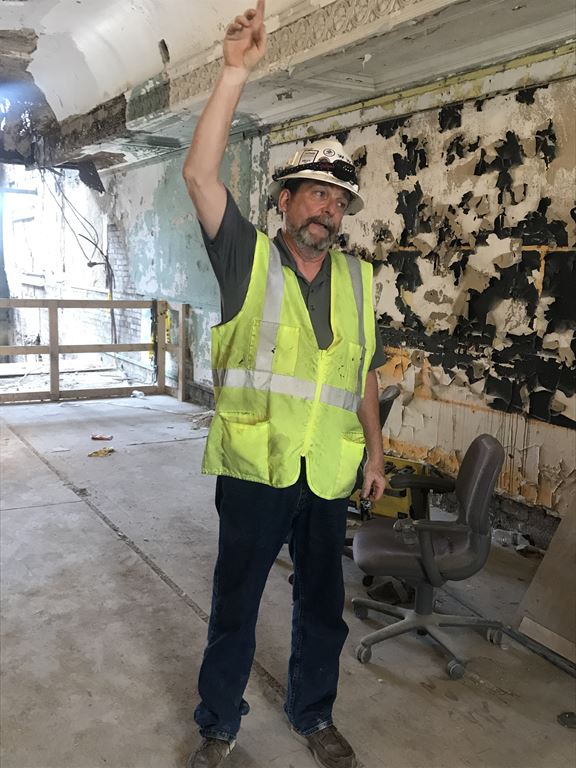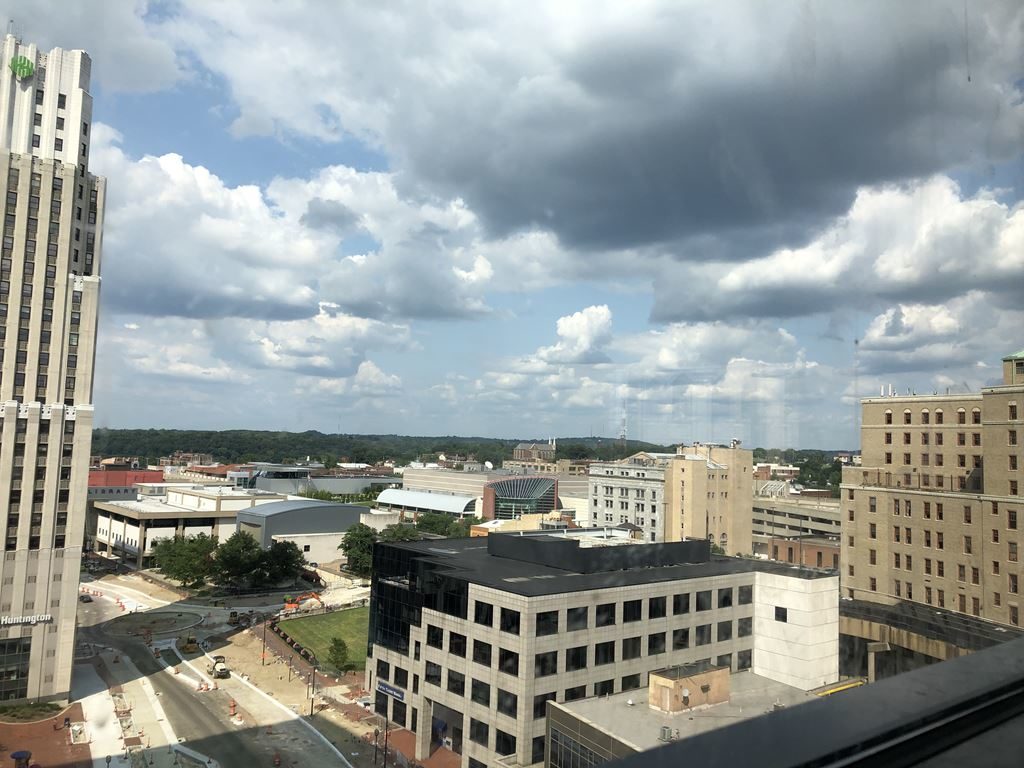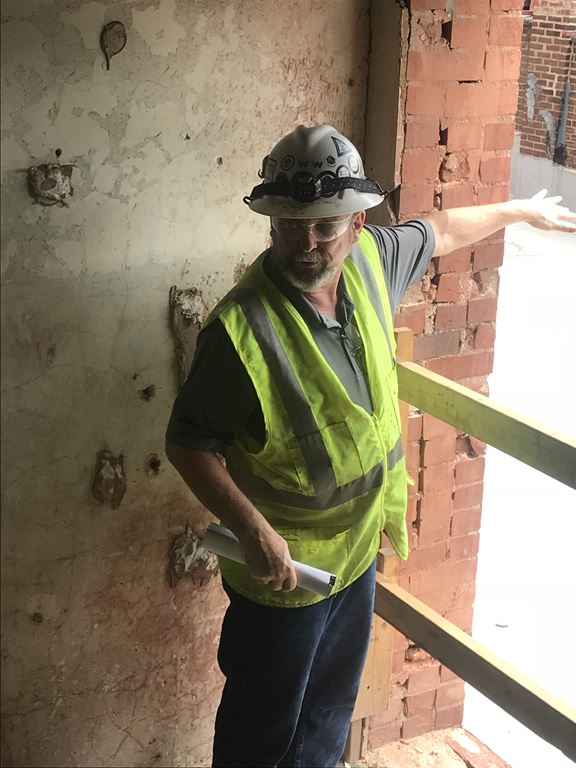When Don Taylor, head of Welty Building Co., envisions the late fall completion of the $42 million Bowery redevelopment in downtown Akron, he’s not quite sure which metaphor he should use.
It will be like going from watching black-and-white TV to color, he said, or seeing a caterpillar that has turned into a butterfly.
In any case, when new apartments and retail space are finished in November, “that part of town will look spectacular,” Taylor said.
Right now, though, that part of downtown looks like a hot mess.
South Main Street is torn up as part of the city’s separate sewer separation project.
The six long-vacant Bowery buildings, meanwhile, that run between the Akron Civic Theatre and West Bowery Street, are covered in part with scaffolding, with empty windows in many places and construction stuff seemingly everywhere. The sound of power equipment, hammering and more echoes in, around and off the structures. One building is currently roofless.
No worries, say Taylor and others.
“The construction is progressing well,” Taylor said. Welty is the project’s general contractor and is also part of the development group.
The Bowery project, which must be live-in ready by Nov. 29 to retain much-needed historic tax credits as part of a complex and still-fluid financing package, is considered crucial to revitalizing the decades-blighted part of Akron and spur additional downtown redevelopment. The Akron Community Revitalization Fund, part of the larger Development Fund of the Western Reserve, on July 26 announced it approved a $1.67 million interim construction loan for the project.
Construction is more than 50% complete, said Taylor and others.
“Does that make sense with the time frame we have left? Yes,” Taylor said. Some 75 to 80 people are working there now, and those numbers will grow in upcoming weeks with additional painters, floor people, cabinet installers and others joining the site, he said.
The Beacon Journal got a recent tour of the buildings.
Since demolition, construction and restoration work started last year and efforts began to find tenants, parts of the project have been tweaked and revised.
For one, the development group initially thought a grocer made the best sense for the ground floor of the tall Landmark building at Main and Bowery to address the “food desert” there and help the project — and the city — woo people to live downtown.
As many as 20 different grocers were approached about setting up shop in the Landmark Building, Taylor said.
“We have gotten a solid round of ‘Nos’ from everybody,” he said.
Now they have much better hope of placing a grocer next door, in the Day-Klein Building, that offers significantly more square footage, Taylor said.
Restaurants and a craft brewery are planned for some Bowery storefronts, and there are other potential commercial clients, Taylor said. “We have at least one interested party for each space,” he said.
Dave Pyott, the on-site project manager, said he is pleased with the progress as he led a tour of the buildings.
The 96-year-old Landmark Building, called Building A in project vernacular and whose office space is being converted into apartments on its upper floors, is closest to completion with drywall being installed and other finishing work underway, Pyott said. Work started on the 12th floor and progressed downward in the former bank and savings and loan building, he said. The South Main ground level space and the rear lower levels that face Lock 4 will be commercial space, he said.
“Buildings B, C, D, and E” — starting next to the Landmark and going toward the Civic Theatre — “are in various stages of construction. We’re approximately 50, 55% complete, on schedule to complete November 29th,” Pyott said. “So, we are still on time, on budget and moving right along.”
Work is taking place five days a week now and will soon go to six days a week, rain or shine, Pyott said. The schedule is aggressive, but it will be met, he said.
“We have really good contractors. These guys are dedicated. They are committed to getting this done,” Pyott said. “A lot of local contractors down here.”
Holes have been cut through the Landmark Building and several of the adjacent structures to provide a central corridor for tenants, Pyott said. In addition, 150 covered parking spaces have been set aside at the next-door Cascade parking structure for Bowery tenants, he said.
Penthouse apartments on the 11th and 12 floors of the Landmark Building offer great views of the city and surrounding areas.
“This is your million dollar view, if you will,” Pyott said.
Apartment square footage begins at about 850 square feet, with the largest unit offering 1,500 square feet and three bedrooms, Pyott said. While some apartments are still having drywall installed, cabinets and kitchen counters are in place in many units, with finishing work underway, he said. Then appliances, including washers and dryers for all units, window treatments and more will be installed.
Rear apartments will have views of concerts and other events at Lock 4.
Marble walls in the corridors are being cleaned and restored on all floors, including patching holes and repairing or replacing defective sections. Architectural details, including crown molding and original flooring, are being restored or replicated. A tin ceiling will be made to look as it did in the 1920s. The Landmark’s ground-floor ornate plaster ceiling will be made to look as good as new.
Elevators are being repaired, and an old mail chute is also being restored, Pyott said.
“You have to bring the elevator lobby back to its original condition,” he said.
“One of the changes we made on the fly here, this was an elevator,” Pyott said, pointing to a door. The space will be turned into a room for people to empty their trash, he said.
Flooring has to be cleaned up, including removing old glue, he said.
Attractive exposed brick walls in some places need to be drywalled over to be historically accurate and to keep the historic tax credits, Pyott said. “It’s sad, it’s very sad. But it has to be done for historic reasons.”
Building exteriors are being repaired and restored by contractor Coon Restoration, he said.
There’s hope that the Landmark will have its first apartment tenants well before the Nov. 29 project completion deadline.
“The owner is taking leases now,” Pyott said. “We are trying for an early occupancy. If we get that, we’ll get them in as early as October, November. … Hopefully, Main Street will be done by then.”
Some commercial and residential tenants will get patios, Pyott said. Building C, the Osterman Building, will have a rooftop deck for tenants.
Building D, the C.E. Link building, about halfway between the Civic Theatre and the Landmark Building, will let people go to and from South Main Street and Lock 4.
“This is access to the canal,” Pyott said.
Work is also being done on the Whitelaw Building, designated Building F and currently roof-less, which will be converted into a small performing arts space immediately next to and affiliated with the Akron Civic Theatre. The developers are in discussion with state preservation officials over how to create unimpaired interior sight lines for event-goers while preserving historic structural details.
“We’re optimistic we’ll make it work,” Welty’s Taylor said.
Howard Parr, executive director of the Civic, said while that part of the Bowery project has slowed down, everything will be completed on time.
“I look down there every day and see people working on the Bowery as a whole,” he said. “From what I see, they’re moving.”
The Civic is undergoing its own multimillion-dollar lobby and arcade interior restoration project and will build a box office and offices on the exterior by Lock 3 Park, including placing a large video screen on the exterior wall overlooking the city space.
“It will be done by the summer of 2020,” Parr said.




